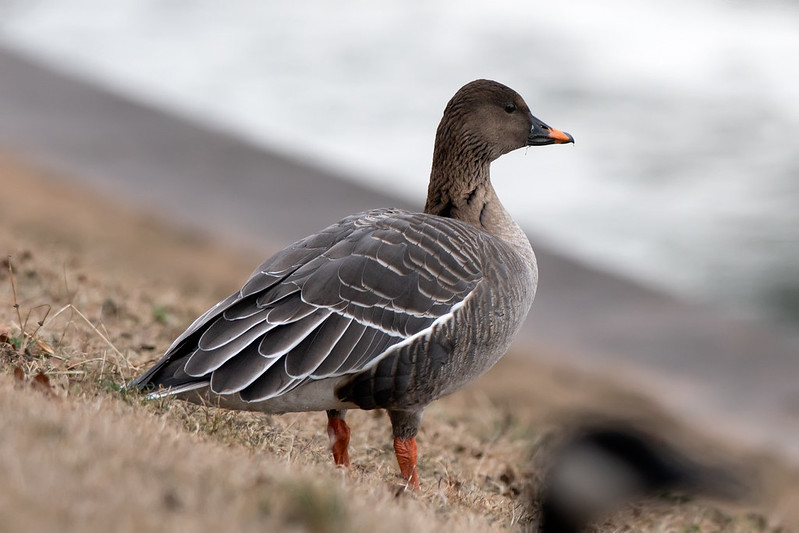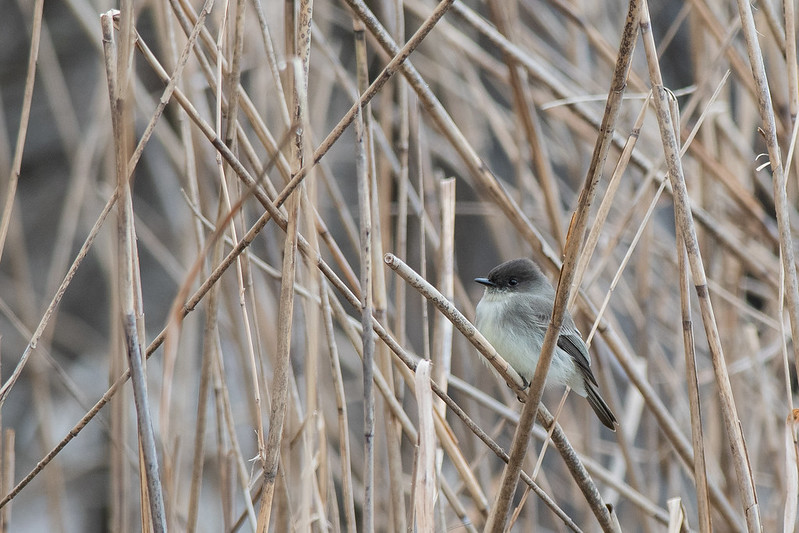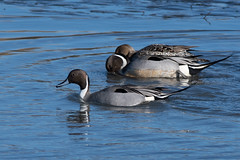John Heinz NWR at Tinicum – Jan. 31st
Year Count: 104 | Species: 25 | FOY Birds: 3 | Lifers: 1

I was hoping to finish out the month of January by beating my old record for species in the month (101), and at the beginning of the day I was tied. Adding to my incentive to get out was an ABA Code 4 rarity, a TUNDRA BEAN-GOOSE which had been sighted in the Fairmount Park area of Philadelphia. I’d already tried twice for this gorgeous bird with no success – in fact, after my last attempt the bird had disappeared for days and I had thought it was gone. Then it was seen again.
I started my morning early, hoping to catch the goose at its roosting spot before it wandered off along the many places along the river. As I was heading there, I figured I would just check out the last place it was seen the day before – at the the stands for the regattas along Kelly Drive. I pulled into a nearby parking lot and braved the frigid cold to walk toward the stands. And I was in luck.
I looked at this small group of Canada Geese, and standing in the middle was this beautiful specimen:
This is a Tundra Bean-Goose, a species that tends to habitate in the the colder, northern realms of Greenland, Iceland and northern Eurasia, only occasionally traveling to Alaska and the northern Canadian Maritimes. The fact that one was hanging out in Philadelphia for an extended amount of time was remarkable. And here it was only a few feet in front of me.


I watched it for awhile as it moved to the Delaware River, moving off with some of the Canada Geese it was hanging out with, and as I watched it swim away, I could barely feel the cold. This was my second lifer for the year and a mega-rarity to boot. What a way to start the day – and I’d broken my record for January!
John Heinz NWR
Background
Next it was off to John Heinz NWR at Tinicum (aka “Tinicum”) to look for a few rarities that had been seen there. Tinicum is a somewhat unique entity in the National Wildlife Refuge system, being the first “Urban NWR” existing entirely within the city limits. Established in 1972 as the Tinicum National Environmental Center, it was built upon the largest tidal marsh in Pennsylvania to protect the fragile habitat. The late senator John Heinz was critical in establishing the land, and the park was renamed in 1991 after the senator’s untimely death.
Due to it’s location, Tinicum is a dichotomy of natural beauty and urban ugliness. Interstate 95 runs along the eastern edge of the refuge, and the Darby creek borders it on the west. The borders are often rife with trash and the noise of the city and the nearby Philadelphia Airport are a constant. But somehow within that shell lies a tranquil natural place, with trails and ponds and large enclosures that attract migrants and waterfowl throughout the year.
On a cold day in January
In this week in January, there had been a number of birds I needed for my nascent year list, including a few rarities like a Eurasian Teal and “Swan Goose” (Canada x Snow goose hybrid). I would end up striking out on the rarities, but the walk was wonderful and the birding enjoyable nonetheless.
Immediately from the parking lots, a large flock of white-throated sparrows greeted me as they scratched their way to a meal in the detritus of leaves and sticks, scarcely noticing my presence. Song sparrows were warier but still focused more on food than the danger I represented.

A small bird flittered past me and landed in the tree nearby. I walked over and to find a ruby-crowned kinglet moving rapidly through the leaveless branches looking for insects to munch upon. Then I was greeted by a uncommon species but one that I can find with some confidence here at John Heinz – a Brown Creeper. I watched as this little bird hopped around nearly as frantically as the kinglet, rapidly moving from trunk to trunk, and creeping (hence the name) its way up each searching for food. It’s adorable to watch if frustrating to try to photograph.

Then it was time to move down the trail toward the impoundments, where my major quarry lay. Cardinals, blue jays and grackles lined the trees. And then there was a call that was a little different, just enough that it caught my attention – a single Rusty Blackbird (another species that I usually add to my year list courtesy of a visit to Tinicum in the spring).

Looking at the water, I was a bit disappointed to find out that they were almost completely frozen over – only small stretches offered any open water, but they were few and far between. A number of ring-billed gulls and couple of dozen American coots were huddled around one of those small fissures. But little else stirred in the water. So the woods it would be.
There was the usual suspects throughout the wooded areas – white-breasted nuthatches honking, chickadees buzzing, titmice whistling and downy & hairy woodpeckers chirping from the trees. A single Cooper’s Hawk flew across the trail in pursuit of some unseen songbird. Carolina wrens sang … well pretty much everywhere.
There’s a smaller pond with a wooden bridge near a blind a short ways up the trail. Just before that bridge a single Eastern Phoebe enjoyed some of the winter sunlight from the reeds, giving me quite a show. That pond is a great spot for Green Heron in the spring and summer, but they were absent in the winter freeze.

Walking up the pipeline trail, I searched for some common residents in the winter – savannah and fox sparrows. This is the best place to find them in the park, but for some reason they were not to be found in this area. Working my way back along the oil spill reclamation area (the park was the site of a major oil spill in the past), I caught a few more common species – red-bellied woodpeckers, blue jays, Carolina chickadee. A single bald eagle flew overhead and a small group of fish crows called from the fields.
As I was walking back, I was able to watch a little show as a ruby-crowned kinglet found a break in the ice and took the opportunity to bathe in an ice bath. It didn’t seem to mind as it washed up and flew off to dry out.

| # | Species |
| 102 | Tundra Bean-Goose* (4) |
| 103 | Brown Creeper |
| 104 | Bald Eagle |
| Canada Goose | |
| American Coot | |
| Ring-billed Gull | |
| Great Blue Heron | |
| Cooper’s Hawk | |
| Red-tailed Hawk | |
| Red-bellied Woodpecker | |
| Downy Woodpecker | |
| Hairy Woodpecker | |
| Eastern Phoebe | |
| Blue Jay | |
| American Crow | |
| Fish Crow | |
| Carolina Chickadee | |
| Tufted Titmouse | |
| Ruby-crowned Kinglet | |
| White-breasted Nuthatch | |
| Carolina Wren | |
| American Robin | |
| White-throated Sparrow | |
| Song Sparrow | |
| Rusty Blackbird | |
| Northern Cardinal |
 Previous Post
Previous Post Next Post
Next Post